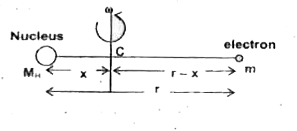In a crystal, the permitted energy states of electrons are present
in the conduction band and the forbidden gap
only in the forbidden gap
in the valence band and conduction band
in the forbidden gap and the valence band
The correct Answer is:C
Step by step video, text & image solution for In a crystal, the permitted energy states of electrons are present by Physics experts to help you in doubts & scoring excellent marks in Class 12 exams.
Topper's Solved these Questions
Similar Questions
Making use of the uncertainty principle,evaluate the minimum permitted energy of an electron in a hydrogen atom and its corresponding apparent distance from the nucleus.
View SolutionShow that ground state energy of an electron in H-atom is equal to the first excited state energy of electron in He+ ion (assuming their Rydberg's constants to be equal ).
View Solution
Knowledge Check
- Question 1 - Select One

The new ground state energy of electron will beAmore than that found with Bohr atomBequal to energy found with Bohr atomCsmaller than energy found with Bohr atomDdata insufficient - Question 2 - Select One
An electron transits from n=3 to ground state in hydrogen atom. If K, P and T are kinetic energy, potential energy and total energy of the electron respectively, which of the following statements regarding the energy of electron is/are correct?
AOnly K increasesBOnly T increasesCBoth P and T decreaseDBoth P and T increase - Question 3 - Select One
The maximum energy is present in any electron at
ANucleusBGround stateCFirst excited stateDInfinite distance from the nucleus
Define crystal field splitting energy. On the basis of crystal field theory, write the electronic configuration for d4 ion if Δ0<P.
View SolutionDefine crystal field splitting energy. On the basis of crystal field theory, write the electronic configuration for d4 ion if Δ0<P.
View SolutionPotential energy of electron present in He+ is:
View SolutionDEFINITION VALID FOR SINGLE ELECTRON SYSTEM :
Ground state:
Lowest energy state of any atom or ion is called ground state of the atom.It is n=1.
Excited State :
States of atom other than the ground state are called excited states.
Ionisation energy (IE):
Minimum energy required to move an electron from ground state to n=∞ is called ionisation energy of the atom or ion.
Ionisation Potential (I.P) :
Potential difference through which a free electron must be accelerated from rest, such that its kinetic energy becomes equal to ionisation energy of the atom is called ionisation potential of the atom.
Excitation Energy :
Energy required to move an electron from ground state of the atom to the atom is called excitation energy of that state.
Excitation Potential :
Potentail difference through which an electron must be accelerated from rest to so that its kinetic energy becomes equal to excitation energy of any state is called excitation potentail of that state.
Binding Energy 'or' Seperation Energy :
Energy required to move an electron from any state to n=∞ is called binding energy of that state.
If the wavelength of photon emitted from an electron jump n=4 to n=2 in a H-like species is 1216Å, then the species is :View SolutionWhat is the potential energy of an electron present in N− shell of the Be3+ ion ?
View Solution

